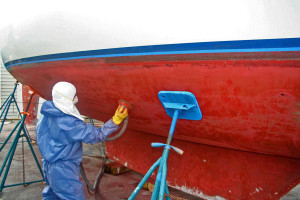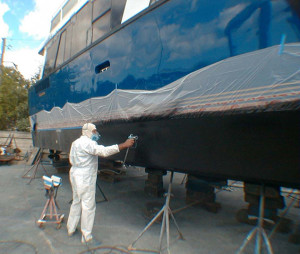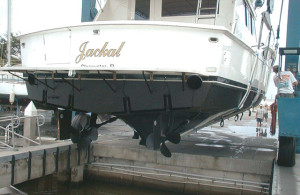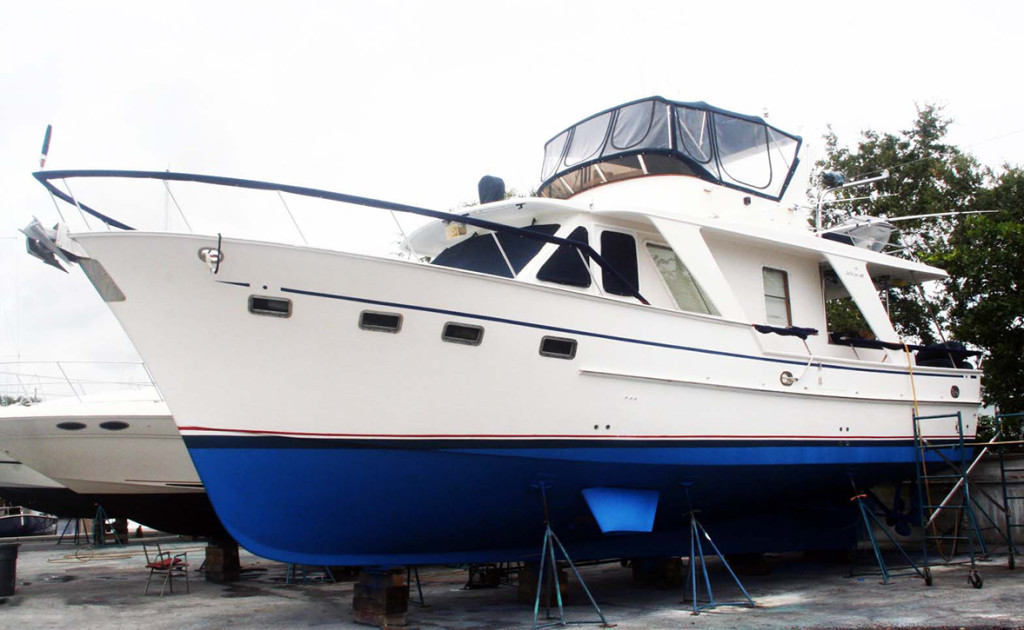Proper way to paint a boat bottom.
Having antifouling paint applied to a boat bottom is the most common part of maintenance on a boat that stays in the water. A clean bottom is fuel efficient and at today’s fuel price it is something you should be concerned about. If you are a sailor and race your boat, it is equally important so you can stay competitive on the race course and if cruising, you will just cruise faster.
 Why do bottom job prices vary so much from boat yard to boat yard? The labor cost is close to being the same (within 5%) and the cost of material should be the same for all yards. So what is the difference?
Why do bottom job prices vary so much from boat yard to boat yard? The labor cost is close to being the same (within 5%) and the cost of material should be the same for all yards. So what is the difference?
Many yards quote on a bottom job using a base number which includes haulout, pressure cleaning and minimal prep for painting. Then, when the boat gets to the yard, the price changes because it had barnacles and that will be an extra charge. Then there will be another charge because it takes more than a couple of hours of prep. Want the entire bottom sanded? That is another charge. Will they paint just one coat on the boat and charge you extra for more paint?
 The Sailor Wharf quotes ONE price and we have been doing it way since 1978. The only time we charge extra for bottom prep is when the barnacles are so large that you may even have oysters on your bottom. If your bottom paint is flaking off, the hull which happens when the original paint was not properly applied or, more common, when the original paint is so old that it no longer has the adhesion to stick to the hull, we would recommend the total removal of the paint.
The Sailor Wharf quotes ONE price and we have been doing it way since 1978. The only time we charge extra for bottom prep is when the barnacles are so large that you may even have oysters on your bottom. If your bottom paint is flaking off, the hull which happens when the original paint was not properly applied or, more common, when the original paint is so old that it no longer has the adhesion to stick to the hull, we would recommend the total removal of the paint.
The proper way to prep a bottom and the only way the Sailor’s Wharf will do the job:
The boat gets hauled, pressure cleaned and the boat gets blocked.
The next step is to sandblast the shaft(s), propeller(s) trim tabs, thru hull fittings, rudder(s) and other metal underwater gear. We then inspect shaft bearing(s) the propeller(s) and rudder(s) for any wear, corrosion, electrolysis and any other issues that can only be seen when a boat is out of the water.
 To properly prep the boat’s bottom, we use vacuum sanders. It is not only the right way of doing it environmentally, it is also more efficient, since the dust is immediately removed and the sandpaper can do its job properly. The worker can also see exactly where he is going, since there will be a clean surface while he is sanding. The next step is to wash all the dust off the bottom and the prop(s) and running gear gets painted with quality metal paint for that purpose. The rest of the bottom gets painted with your choice of anti fouling paint which, we either roll or spray on, with an airless paint sprayer depending on the customer’s choice. We move the boat stands so we can have the entire boat painted except for the keel blocks. When the paint is dry (usually 24 hours) we lift the boat and paint the keel block areas and inspect the bottom one last time. When the final paint touchup is dry, we launch the boat and wash the deck.
To properly prep the boat’s bottom, we use vacuum sanders. It is not only the right way of doing it environmentally, it is also more efficient, since the dust is immediately removed and the sandpaper can do its job properly. The worker can also see exactly where he is going, since there will be a clean surface while he is sanding. The next step is to wash all the dust off the bottom and the prop(s) and running gear gets painted with quality metal paint for that purpose. The rest of the bottom gets painted with your choice of anti fouling paint which, we either roll or spray on, with an airless paint sprayer depending on the customer’s choice. We move the boat stands so we can have the entire boat painted except for the keel blocks. When the paint is dry (usually 24 hours) we lift the boat and paint the keel block areas and inspect the bottom one last time. When the final paint touchup is dry, we launch the boat and wash the deck.


Written by: J. Jopie Helsen, www.sailorswharf.com, [email protected]

